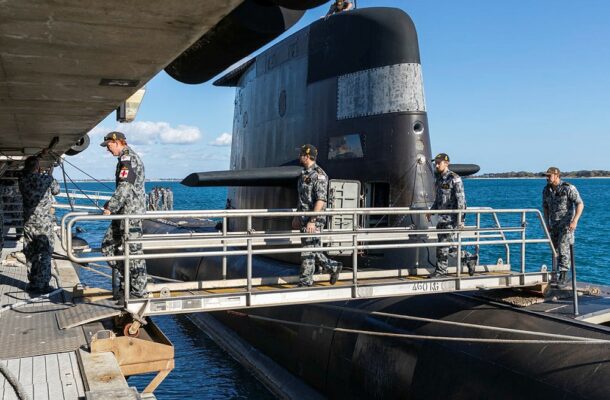Submarines mean security

While we await the AUKUS partners’ announcement of their plans for Australia to acquire nuclear-powered submarines (SSNs), the public discourse on the agreement has become wildly out of sync with reality.
Charges that Canberra’s SSN program might promote conflict with Beijing or start a nuclear arms race need to be evaluated far more critically. Key to understanding the impetus for the trilateral agreement are considerations driven by the regional dynamics of military acquisitions as well as international agreements on the control of nuclear material.
Uncritically accepting the positions put forth by Beijing and Moscow would not only mean Australia abrogating its sovereign right to make decisions about its own national defence but also be detrimental to the interests of Southeast Asian nations. Acting Prime Minister and Defence Minister Richard Marles and opposition leader Peter Dutton both told parliament yesterday that acquiring the submarines was about maintaining peace in the region rather than going to war.
Submarines have been a regular presence across the Indo-Pacific for decades. Indonesia, one of the more vocal critics of Australia’s plans, operated the largest submarine fleet in the region in the 1960s and 1970s with a force of 12 Whiskey-class diesel-electric submarines obtained from the Soviet Union.
Today, its submarine force numbers four, following the tragic loss of KRI Nanggala in 2021. The Royal Malaysian Navy operates two Scorpene-class submarines. Singapore has four submarines and has placed orders for an additional four modern boats. Vietnam has three modern Kilo-class submarines purchased from Russia.
Thailand and the Philippines are actively pursuing submarines, although Bangkok’s planned purchase of Chinese Yuan-class boats appears to be foundering. So, in maritime Southeast Asia, only Cambodia and Timor-Leste aren’t operating or actively pursuing submarines as part of their maritime strategies.
It seems safe to assume that none of these states consulted Canberra while developing their submarine programs. However, both Malaysia and Indonesia have voiced their opinions that Australia’s pursuit of SSNs risks a regional arms race—while remaining painfully silent on the subject of an unprecedented naval expansion to the north being carried out by the People’s Liberation Army Navy. Somehow submarines that don’t even exist yet have caused more regional consternation than a scores-strong fleet that is not only nuclear-propelled but armed with nuclear weapons as well.
It is the height of hypocrisy for the Chinese government to hyperventilate over a nuclear-powered submarine program in Australia when the PLA Navy has commissioned at least 15 SSNs in the past two decades, several of which carry nuclear-tipped intercontinental ballistic missiles. The Chinese sub fleet is projected to grow by at least 10 more boats by 2030.
Under Australia’s plan, the Royal Australian Navy may only start receiving its new submarines by that point. In the meantime, Australia’s ageing Collins-class boats will likely need to serve well past their intended decommissioning dates. In fact, one of the key questions that the AUKUS partners are expected to answer next week is how Australia will avoid a submarine capability gap.
Beijing’s disingenuous talking points have also surfaced in Russian circles. Russian officials have implied that an Australian SSN program will weaken the international non-proliferation regime and contribute to an acceleration of the imagined arms race. In fact, the Treaty on the Non-Proliferation of Nuclear Weapons doesn’t restrict non-nuclear-weapon states from developing ships or submarines powered by nuclear reactors; nor does it have provisions for overseeing the nuclear material committed to such a program.
It is equally incredible that the Russian government would criticise a state for embarking on an SSN program when the Russian Navy already operates a significant fleet of SSNs itself and has leased some of them to India. Having repeatedly threatened to use nuclear weapons as part of its illegal invasion of Ukraine, Moscow should be perhaps the last capitol on earth to criticise Australia for seeking a completely legal nuclear-propulsion capability for its own navy.
Australia has taken great pains to assuage concerns across Southeast Asia, reiterating its commitment to the Nuclear Non-Proliferation Treaty and attempting to correct misperceptions about the nature of AUKUS—namely, that it is a technology-sharing mechanism, not an operational network or alliance.
Technology sharing among partners is normal across the globe, including among the states that are the biggest critics of the AUKUS partnership. It appears, rather, that those states using their navies to impose their will upon their neighbours, from Russian naval strikes against Ukraine to Chinese ships enforcing illegal claims at sea, are effectively demanding that the world ignore their aggression and remain vulnerable to their military expansions.
With a full grasp of the facts, it’s plain that accusing Australia of contributing to an arms race is absurd, particularly when an aspiring regional hegemon already has 11 times Australia’s submarine strength in a navy seven times bigger than the RAN. An arms race requires at least two competitors, but there’s only one state in the Indo-Pacific that’s sprinting toward expanding its naval power—and that is China.
Asia has enjoyed a long period of relative peace and prosperity that is increasingly jeopardised by China’s intimidation campaign at sea and by its threats of violent invasion of Taiwan. Some regional powers, such as India, Australia, Japan and the United States, are eager to deter China from undertaking a catastrophic war of aggression that would upend the world economy.
The measures required to deter China—which include developing modern military capabilities commensurate with those already possessed by Beijing—will necessarily generate some discomfort in the short term as China attempts to intimidate states into inaction. However, rather than adopt Beijing’s talking points, regional states might well consider what the regional order would look like should war not be deterred.
AUKUS holds out the promise of an extension of the Asian peace and a reduction in the likelihood that China will use its rapid and massive military expansion to resort to naked aggression. The AUKUS initiatives are designed to foster peace and stability in the region by maintaining the long-term regional military balance, which is surely worth enduring a bit of short-term discomfort.
This article was published by The Strategist.
Blake Herzinger is a research fellow in the foreign policy and defence program at the United States Studies Centre at the University of Sydney and a non-resident fellow at the American Enterprise Institute.







